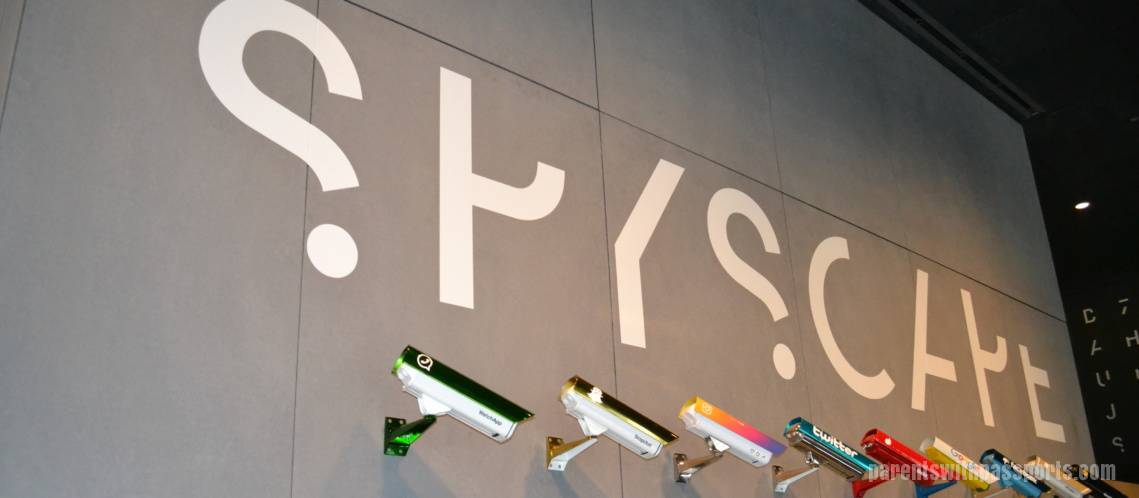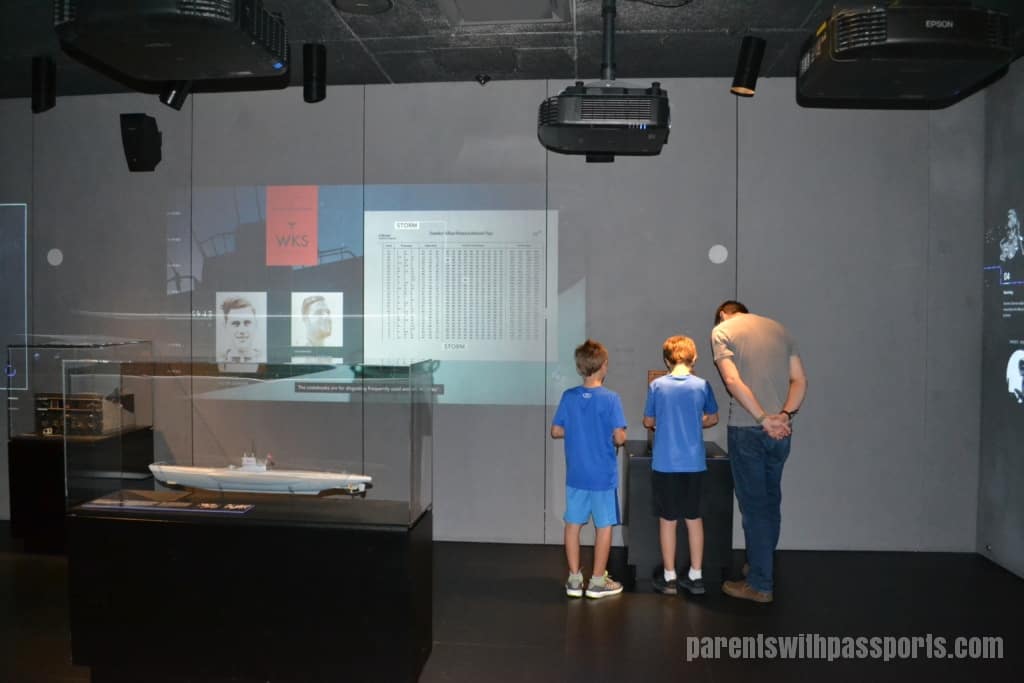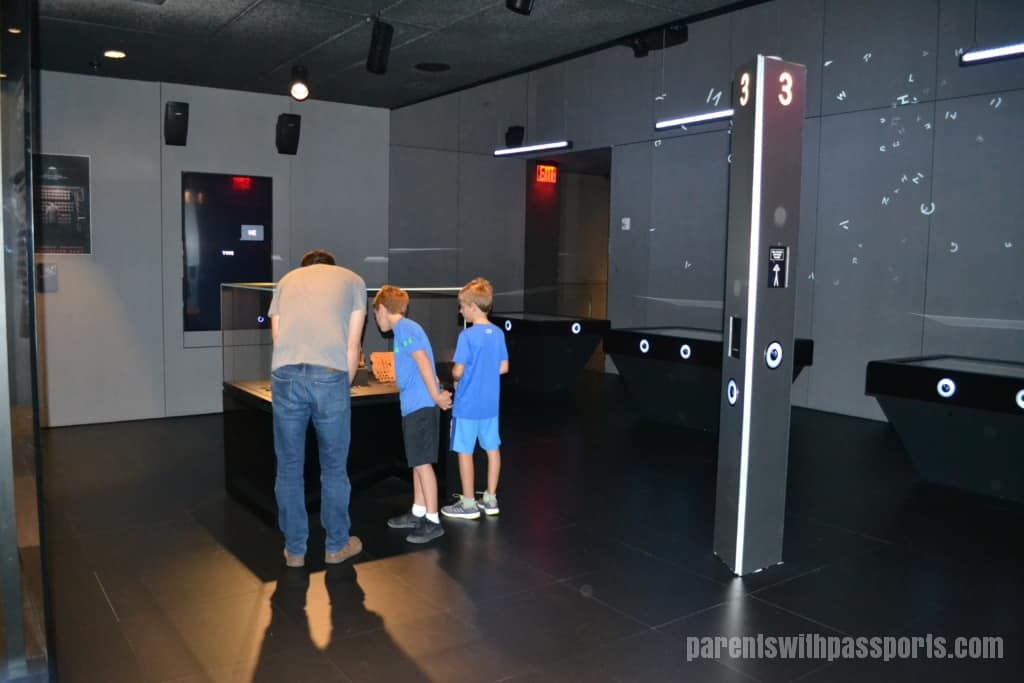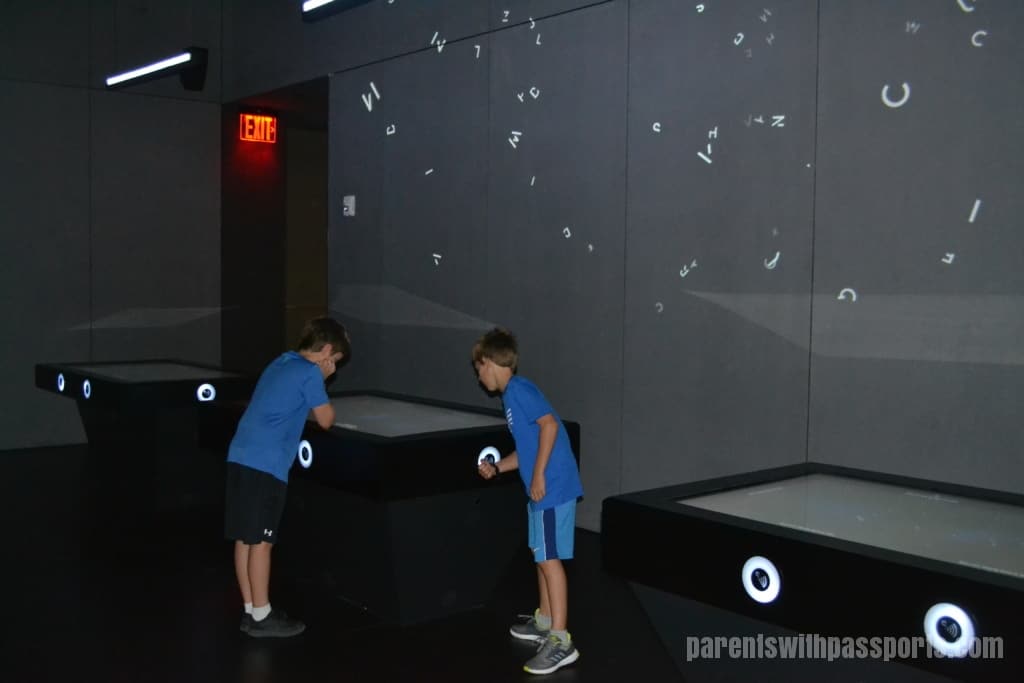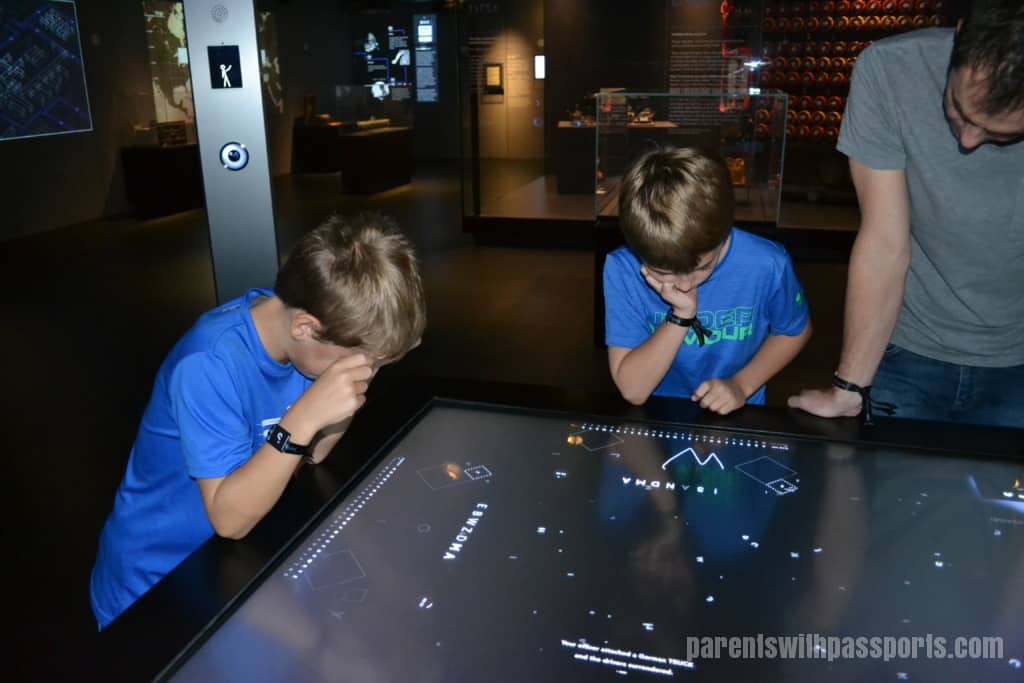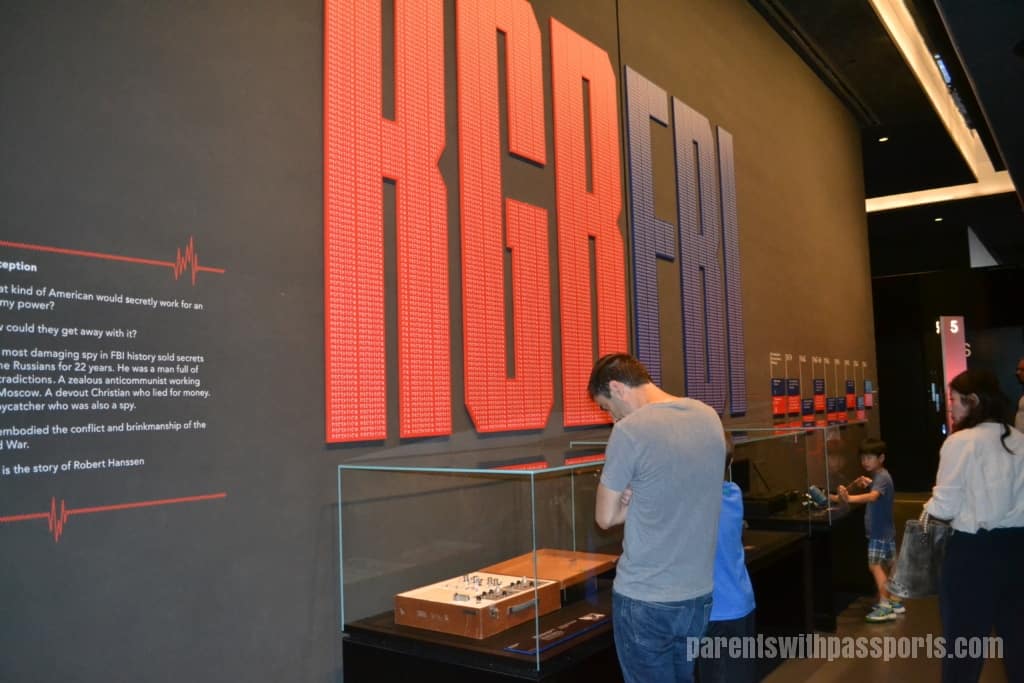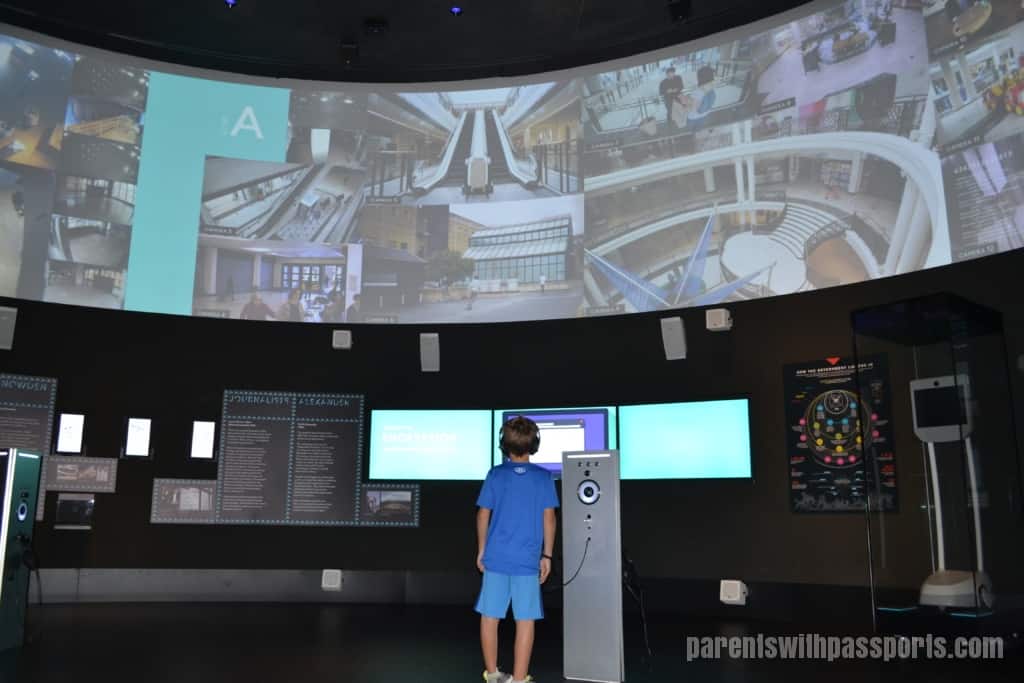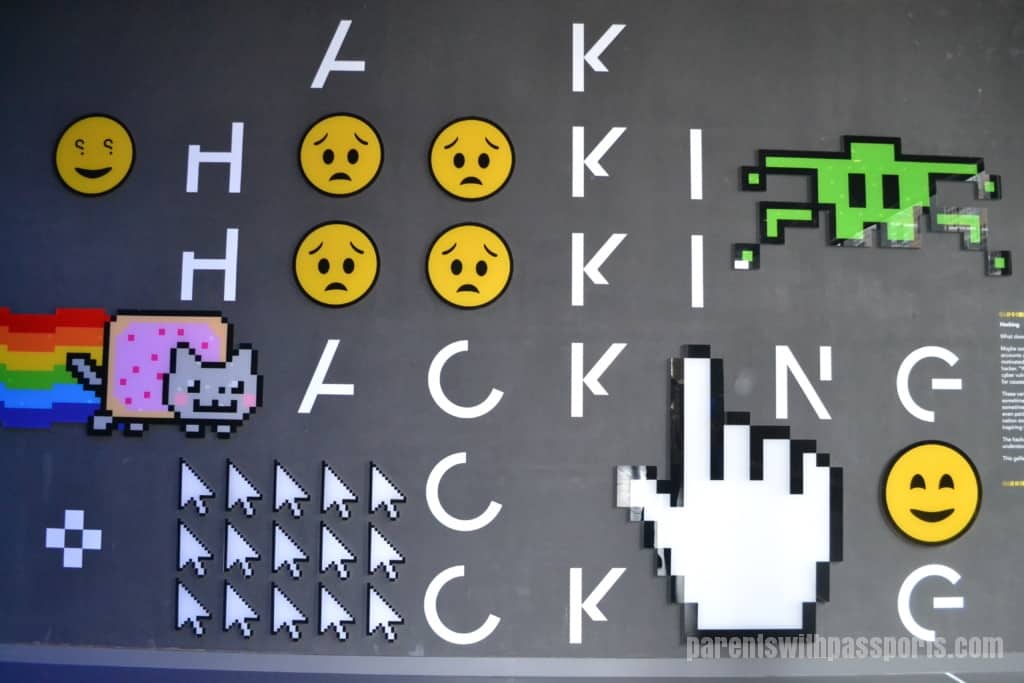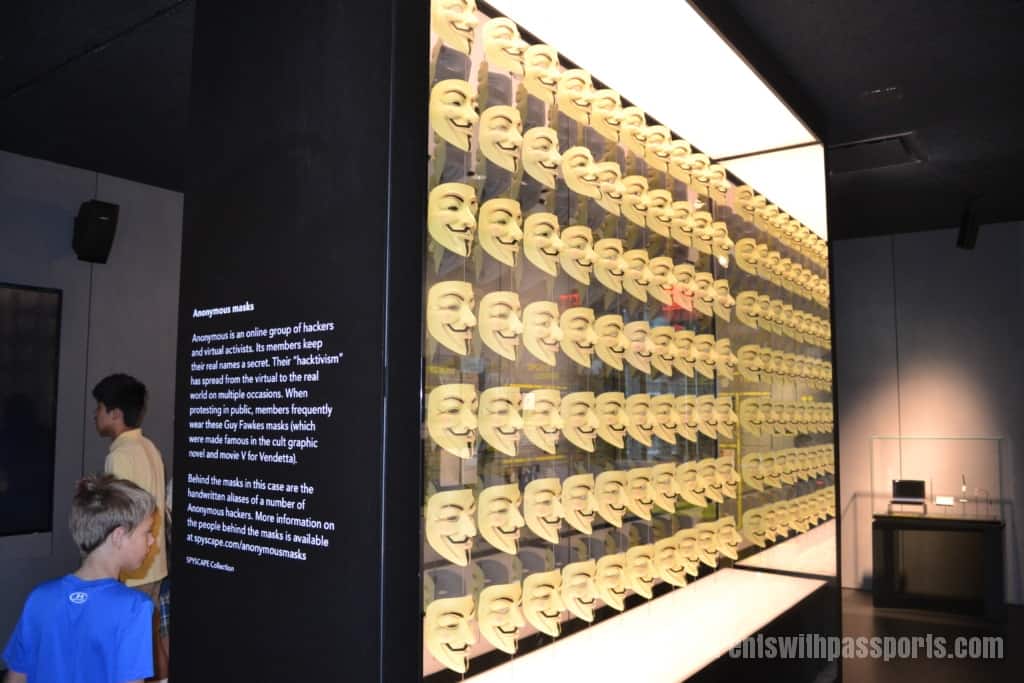Spyscape is part spy museum and part interactive spy experience. For the interactive part, you go through a series of tests and challenges in order to determine what type of spy you are best suited to be. It is expensive at $39 for adults and $32 for kids, but what isn’t expensive in NYC? It is aimed at teenagers and adults but my 8 and 10 year olds were old enough to enjoy it. My 8 year old needed a little help through a few spots but it didn’t diminish his experience at all.
After purchasing your tickets, you are given a digital wristband that you use to scan in at various stations around the museum. It gathers your data and compiles your spy profile, ultimately matching you with a specific type of spy. You begin with an overview from an employee and then scan your wristband to complete some intelligence tests at one of the Question Stations. Then you are loaded into an enormous elevator that moves almost imperceptibly to the second floor while you watch a large screen video briefing. The slightly paranoia-inducing video talks about the prevalence of spying in the world around you and sets the stage for the interactive exhibits that are about to be revealed when the elevator doors open.
The museum is completely unique, a fascinating blend of modern design and state of the art technology. There are six galleries dedicated to different forms of espionage: encryption, deception, surveillance, hacking, special ops, and intelligence. Each gallery functions as a museum, providing details of historical events and figures related to the specific topic, as well as displaying interesting artifacts. Four of the galleries include hands-on activities, your success (or not) in which determines the type of spy you are best suited to be.
The first gallery is encryption, and it included a really cool code-breaking activity that was probably my boys’ second favorite of the activities. After checking out the displays and learning about the historical use of codes in WWII and intelligence operations, we had the opportunity to break a code in order to communicate with and rescue a spy.
The next exhibit and activity was about deception. This exhibit told the story of Robert Hanssen, who spied for the Russians for 22 years. The activity at the end tested your ability to both tell a lie and spot a liar. A video taught you about different “tells” a person has when they are lying and then had you watch several people being interviewed by law enforcement and guess whether they were lying or not. Then the tables were turned and you had to lie convincingly without using any of the tells. (Should I be worried that both my boys successfully complete this challenge?)
After that it was on to the surveillance room. This was probably the coolest room in the museum and the hardest challenge. You walked into a giant circular room with huge surveillance screens encircling the room. In this timed challenge, you put on a set of headphones and were instructed to look at a section of the room and find a specific image and state what camera it was on. This was hard. Very hard. Picking out one minute detail from a huge amount of visual data was really challenging. I will also say that this was one of the more frustrating activities as well because the headphones did not always accurately pick up your response. While there were many that I legitimately missed, there were also quite a few that I got correct but could not get the computer to understand my response. This especially frustrated my youngest. But still, the room itself was visually dramatic and it really made you think about how often you are recorded in your day to day activities.
The Hacking exhibit was next, featuring a full wall of Anonymous masks from the online hacking group. My oldest walked quickly through this exhibit, as he found the masks really creepy. The exhibit gave some examples of famous hackings, as well as tips to protect yourself from hacking. This was definitely the one area that went over my kids’ heads and held little interest for them. There was no activity in this area so we passed through it quickly.
But what the hacking exhibit lacked in interest for young kids, the next made up for and then some. Next up was the Special Ops Challenge. You entered a tunnel criss-crossed with lasers and covered with illuminated buttons on the wall. In this timed challenge, you had to hit as many of the buttons as you could without tripping any of the lasers. Hitting more buttons increased your score but tripping a laser took away from your total. At the end, the lasers go way and there is a frenzied last push to hit as many buttons as you can before time runs out. This was so much fun for kids and parents alike. (For the record, I lost to my husband by one lousy point. So close!)
The final exhibit was Intelligence and it focused on Oleg Penkovsky, known as “the spy who saved the world”. The intelligence he shared with the CIA helped diffuse the Cuban Missile Crisis and avoid World War III. There was an interesting video and some good information in this exhibit.
In addition to the four challenges, the final piece of your spy puzzle is formed at the Question Stations (tablet kiosks) found throughout the exhibits. These electronic tests assess your intelligence, personality, and risk tolerance. The intelligence questions were mind-bending logic puzzles, many of which were really difficult for young children. My youngest guessed on a lot of them and my oldest tried to figure them out but ran out of time on many. The personality test asked you to rate how well 12 statements described you. For example, “I take risk only if it is absolutely necessary to achieve an important goal.” Many of your responses elicit a humorous response from the computer, such as “So you said you don’t get stressed out easily. I’ll have to try harder…” And finally the risk assessment used a balloon popping game to determine how risk-averse you are. The more balloons you fill, the more money you get. But they could pop at any time so you had determine if you wanted to take a chance for more money or bank what you already had. My results speak for themselves:
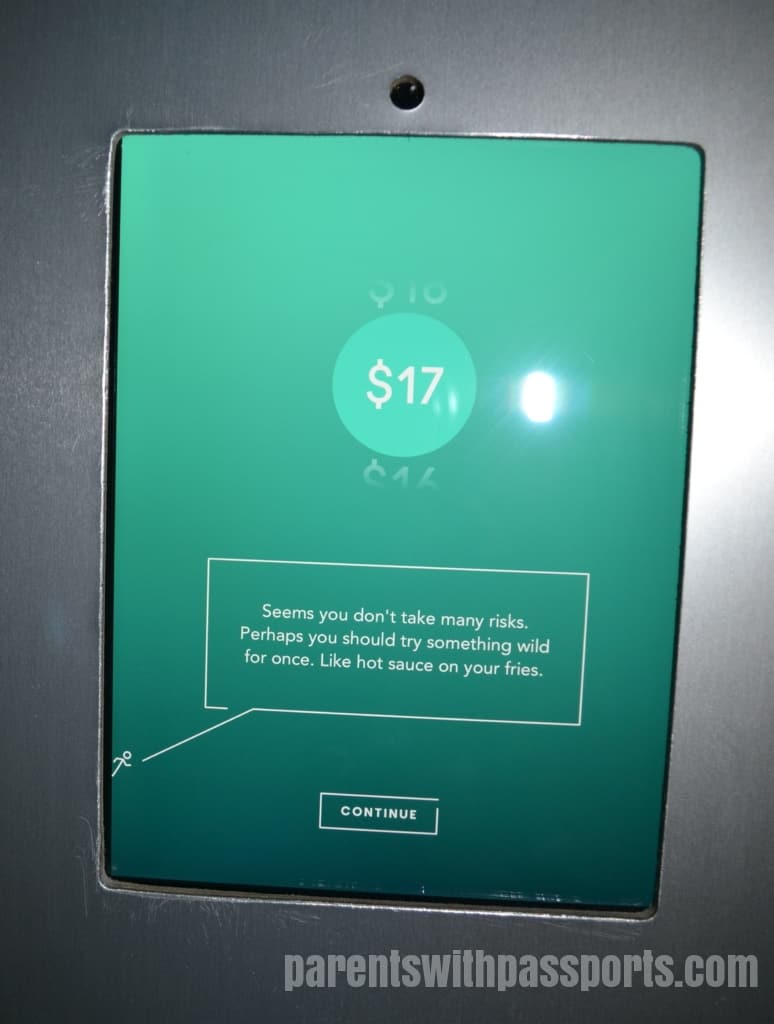
After viewing all the exhibits and completing all four challenges and three categories of questions, you get to go to debrief to “discover your inner spy.” All your data is compiled and run through a complex algorithm to determine what intelligence role you are assigned. There are 10 possible roles: Spymaster, Intelligence Analyst, Spycatcher, Hacker, Cryptologist, Agent Handler, Surveillance Officer, Technical Operations Officer, Special Operations Officer, and Intelligence Operative.
So what kind of spies am I living with? Well, the boys and I were all scored as Intelligence Operatives, while my husband ended up a Special Ops Officer. Here are the descriptions from the Spyscape website:
Intelligence Operative: The heart of an intelligence organization, involved in an array of operations, from servicing dead drops to setting up safe houses.
Special Operations Officer: Someone who gathers intelligence and destroys targets in hostile environments.
So there you have it. We are officially a family of spies. We had a great time at Spyscape. It was both educational and fun. All told, we spent about two hours there and that was plenty of time to really read all the information in the exhibits and to complete the tasks. I highly recommend this to families with older kids. Teenagers are the prime age but don’t be scared to bring kids in the 8-12 range if you think this will interest them. Some of the Question Station tests were too difficult for young kids, but both my boys were able to complete all the spy challenges themselves and had a blast doing so.
